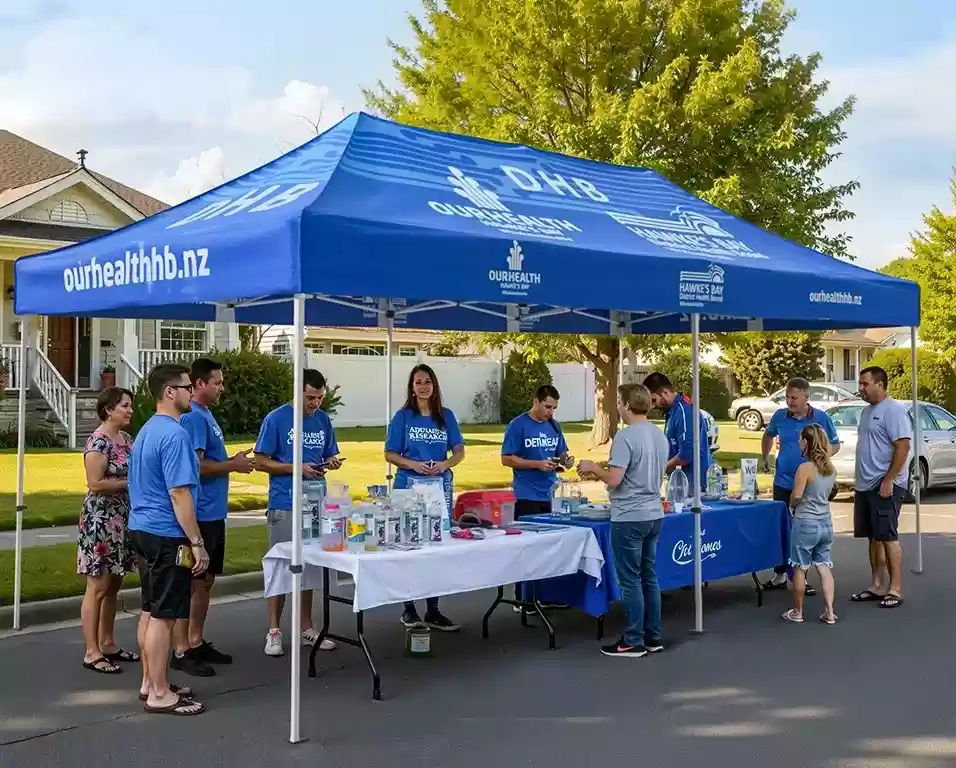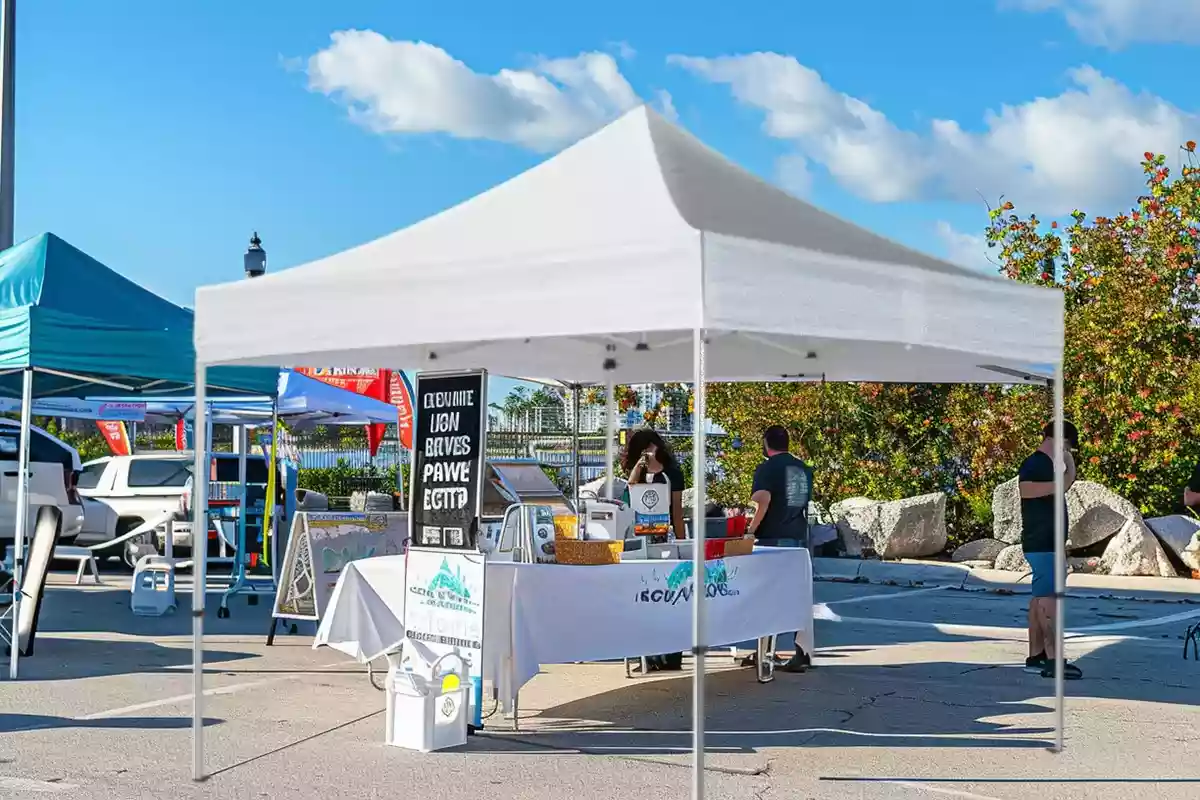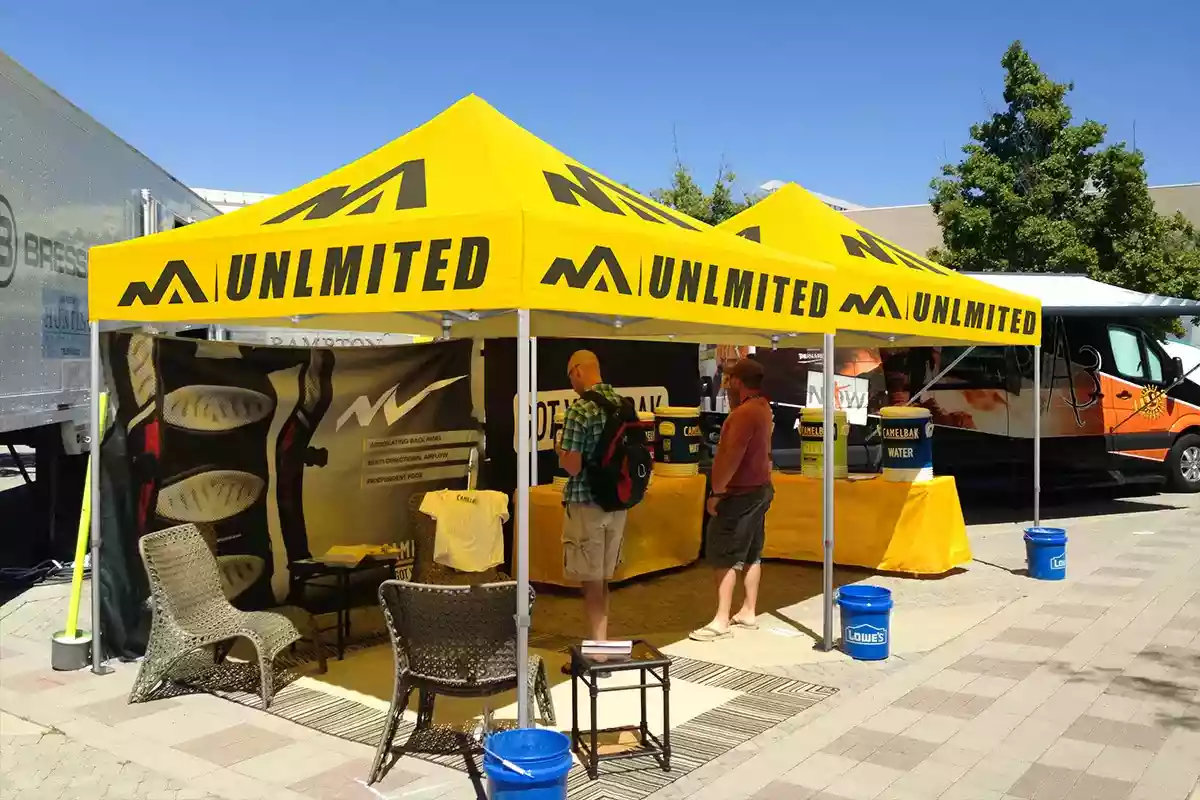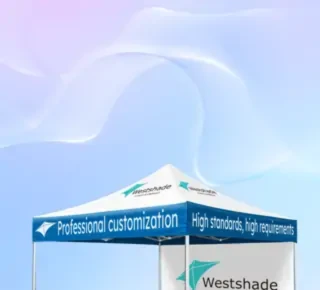
When it comes to running a successful outdoor event, nothing is more frustrating than seeing your pop-up tent take flight and land several meters away. The wind can be a formidable adversary, but fret not; we have the essential tips to ensure your tent stays securely anchored to the ground, safeguarding your business and protecting your investment.
In this article, we will explore the best practices for anchoring your pop-up tent, from choosing the right anchoring system to properly setting it up. We will walk you through different options, including tent weights, ground stakes, and sandbags, weighing the pros and cons of each to help you make an informed decision. Additionally, we will share expert tips on positioning your tent strategically to minimize wind resistance and maximize stability.
Whether you’re hosting a farmers market, a food festival, or an outdoor trade show, having a secure and stable canopy tent is crucial to your business’s success. So buckle up and get ready to learn the tricks of the trade to keep the wind from blowing away your business.
The Importance of Anchoring Your Pop-Up Tent

When setting up a pop-up tent for your outdoor event, it’s easy to overlook the importance of properly anchoring it. However, failing to do so can have disastrous consequences for your business. A tent that is not securely anchored can be easily blown away by strong winds, potentially causing damage to your property and putting attendees at risk. Moreover, a tent that is not stable can give off an unprofessional and disorganized image, negatively impacting your brand’s reputation.
To avoid these problems, it’s crucial to understand the importance of anchoring your pop-up tent. Not only does it provide stability and safety, but it also ensures that your event runs smoothly, without any unexpected interruptions. By investing in the right anchoring system and following the proper installation techniques, you can protect your business and create a positive experience for your attendees.
Types of Pop-Up Tent Anchoring Systems
When it comes to anchoring your pop-up tent, there are several options to choose from. Each system has its own advantages and disadvantages, and the right choice depends on various factors such as the type of event, location, and ground conditions. Let’s take a closer look at the most common types of anchoring systems:

1. Tent Weights: Tent weights are a popular choice for anchoring pop-up tents, especially in locations where staking is not possible. These weights are typically made of heavy-duty materials such as steel or concrete and are designed to be placed on each corner of the tent. They provide stability by adding weight to the structure, preventing it from being easily lifted by strong winds. Tent weights are easy to transport and install, making them a convenient option for outdoor events.

2. Ground Stakes: Ground stakes are another widely used anchoring system for pop-up tents. They are long, metal pegs that are driven into the ground through the tent’s stake loops. Ground stakes provide excellent stability, especially in soft or grassy terrain. They are relatively inexpensive and easy to use, making them a popular choice for many event organizers. However, it’s important to note that ground stakes may not be suitable for all locations, such as concrete or asphalt surfaces.

3. Sandbags: Sandbags are a versatile and portable anchoring solution for pop-up tents. They are filled with sand and placed on each corner of the tent or along the perimeter to provide stability. Sandbags work well on various ground surfaces, including grass, concrete, and asphalt. They are particularly effective in windy conditions, as the weight of the sand prevents the tent from being lifted. Sandbags are easy to store and transport, making them a practical choice for outdoor events.
Of course, if you want to DIY your anchoring systems, here’s an article for reference on using a cheaper way to avoid embarrassment at the show.
Understanding Wind Load and Its Impact on Pop-Up Tents

To effectively anchor your pop-up tent, it’s important to understand the concept of wind load and how it affects the stability of your structure. Wind load refers to the force exerted by the wind on the surface of the tent, which can vary depending on factors such as wind speed, direction, and the shape of the tent. The higher the wind load, the more pressure it puts on the tent, increasing the risk of it being blown away.
Different brands and types of tents have different wind load ratings, which indicate the maximum wind speed the tent can withstand without damage. It is critical to select a tent with the right wind load rating for the specific conditions of the event. For reference, Westshade’s Y7 canopy tent can withstand winds of 35 to 45 mph. Additionally, proper anchoring is critical to evenly distribute the wind load and prevent the tent from tipping or collapsing.
To determine the wind load on your tent, you can consult wind load calculators or seek advice from tent manufacturers. By understanding the wind load and its impact, you can make informed decisions when selecting anchoring systems and ensure the safety and stability of your pop-up tent.
Tips for Selecting the Right Anchoring System for Your Pop-Up Tent

When selecting an anchoring system for your pop-up tent, it’s important to consider various factors to ensure the best possible stability and safety. Here are some tips to help you choose the right anchoring system for your specific needs:
1. Assess the Ground Conditions: Before deciding on an anchoring system, evaluate the ground conditions at your event location. Is it grassy, sandy, concrete, or asphalt? Different surfaces may require different types of anchors. For example, ground stakes work well on grassy surfaces, while sandbags are more suitable for concrete or asphalt.
2. Consider the Wind Load: Take into account the wind load rating of your tent and the typical wind conditions of your event area. If you anticipate strong winds, opt for a more robust anchoring system, such as tent weights or sandbags, to ensure maximum stability.
3. Evaluate Portability and Ease of Setup: Consider the convenience and portability of the anchoring system. Will you need to transport the anchors frequently? Are they easy to set up and remove? Tent weights and sandbags are often preferred for their portability and ease of use.
4. Seek Professional Advice: If you’re unsure about the best anchoring system for your specific needs, don’t hesitate to consult with professionals or tent manufacturers. They can provide valuable insights and recommendations based on their expertise and experience.
By carefully considering these tips, you can select the right anchoring system for your pop-up tent, ensuring a secure and stable setup for your outdoor event.
Anchoring Techniques for Different Ground Surfaces

The anchoring technique you use for your pop-up tent will depend on the ground surface at your event location. Here are some guidelines for anchoring your tent on different types of surfaces:
1. Grass: Grass surfaces are generally more forgiving and allow for easier anchoring. Ground stakes are a popular choice for grassy areas, as they can be driven into the ground to provide excellent stability. Make sure to fully insert the stakes and angle them away from the tent for maximum hold. If the ground is particularly soft, you can reinforce the stakes with additional support, such as tying them to nearby trees or using sandbags.
2. Concrete and Asphalt: Anchoring a pop-up tent on concrete or asphalt surfaces requires different techniques. Tent weights or sandbags are the preferred options in these cases. Place the weights or sandbags on each corner of the tent or along the perimeter, ensuring they are securely positioned. You may also consider using straps or bungee cords to further secure the tent to nearby fixed structures, such as poles or fences.
3. Sand: If your event is taking place on a sandy beach or desert area, sandbags are the ideal anchoring solution. Fill the sandbags with sand and place them on each corner of the tent or along the perimeter. Ensure that the sandbags are properly secured to prevent them from shifting or being carried away by wind or water.
By following these anchoring techniques for different ground surfaces, you can ensure the stability and safety of your pop-up tent, regardless of the location of your outdoor event.
Proper Installation and Setup of Anchoring Systems

Installing and setting up your anchoring systems correctly is crucial to ensuring the stability and safety of your pop-up tent. Here’s a step-by-step guide to help you properly install and set up your anchoring systems:
1. Prepare the Ground: Clear the ground of any debris, rocks, or other obstacles that could interfere with the installation process or potentially damage the tent. Smooth out the surface if necessary.
2. Position the Tent: Set up the tent in the desired location, ensuring it is level and aligned with the ground. Use a tape measure or other tools to ensure that the tent is set up to the correct dimensions.
3. Assemble and Attach the Anchors: Depending on the type of anchoring system you’re using, assemble the tent weights, ground stakes, or sandbags as needed. Attach the anchors to the tent by following the manufacturer’s instructions. Make sure that the anchors are firmly attached and positioned correctly.
4. Secure the Anchors to the Ground: For ground stakes, drive them into the ground at an angle, ensuring they are fully inserted and angled away from the tent. For tent weights or sandbags, place them on each corner of the tent or along the perimeter, ensuring they are positioned securely.
5. Check for Stability: Once the anchors are in place, shake the tent gently to check for any movement or instability. If the tent feels loose or wobbly, readjust the anchors or consider using additional support, such as straps or bungee cords.
By following these installation and setup guidelines, you can ensure that your anchoring systems are properly installed, providing the stability and security needed for your pop-up tent.
Maintenance and Inspection of Anchoring Systems
To ensure the ongoing stability and safety of your pop-up tent, it’s important to regularly inspect and maintain your anchoring systems. Here are some maintenance tips to keep in mind:
1. Regular Inspections: Perform regular inspections of your anchoring systems, checking for any signs of wear, damage, or corrosion. Look for loose or missing parts and replace them promptly.
2. Clean and Dry: Keep your anchoring systems clean and dry to prevent rust or deterioration. Remove any dirt, debris, or moisture that may accumulate on the anchors.
3. Retighten and Reinforce: Periodically retighten the anchors to ensure they remain securely in place. If you notice any signs of instability, reinforce the anchoring system by adding extra support, such as additional weights or stakes.
4. Replace as Needed: Over time, anchoring systems may become worn out or damaged. If you notice any significant wear or damage, replace the anchors promptly to maintain the stability and safety of your pop-up tent.
By regularly inspecting and maintaining your anchoring systems, you can prolong their lifespan and ensure that they continue to provide the necessary stability for your pop-up tent.
Additional Safety Measures for Windy Conditions

While properly anchoring your pop-up tent is crucial for stability and safety, there are additional measures you can take to further protect your tent in windy conditions. Here are some extra safety tips to consider:
1. Windbreakers: Position your tent strategically to take advantage of natural windbreakers, such as buildings, trees, or fences. These barriers can help reduce the impact of strong winds on your tent.
2. Guy Lines: Guy lines are additional ropes or cords that can be attached to the tent and anchored to the ground. They provide extra support and stability, particularly in high-wind situations. Place guy lines at an angle away from the tent to prevent it from being lifted.
3. Monitor Weather Conditions: Stay informed about the weather forecast for your event area. If high winds or severe weather are predicted, consider postponing or rescheduling your event to ensure the safety of your attendees and the integrity of your tent.
By implementing these additional safety measures, you can minimize the risk of damage to your pop-up tent and ensure the safety of everyone at your outdoor event.
Common Mistakes to Avoid When Anchoring Your Pop-Up Tent
When it comes to anchoring your pop-up tent, there are some common mistakes that event organizers often make. By being aware of these mistakes, you can avoid them and ensure a secure and stable setup for your tent. Here are some common mistakes to avoid:
1. Underestimating Wind Load: Failing to consider the wind load of your tent and the wind conditions of your event area can lead to inadequate anchoring and potential damage. Always choose a tent with an appropriate wind load rating and use anchoring systems that can withstand the expected wind conditions.
2. Improper Installation: Rushing through the installation process or not following the manufacturer’s instructions can result in an unstable tent. Take the time to properly install and set up your anchoring systems, ensuring that they are securely attached and positioned correctly.
3. Neglecting Maintenance: Over time, anchoring systems can deteriorate or become worn out. Neglecting regular inspections and maintenance can compromise the stability and safety of your tent. Make sure to inspect and maintain your anchoring systems regularly, replacing any damaged or worn-out parts promptly.
4. Ignoring Weather Conditions: Failing to monitor and respond to changing weather conditions can put your tent and attendees at risk. Stay informed about the weather forecast for your event area and take appropriate action if severe weather or high winds are predicted.
By avoiding these common mistakes, you can ensure the stability, safety, and success of your pop-up tent at any outdoor event.
Conclusion and Final Thoughts

Anchoring your pop-up tent is a critical step in ensuring the stability, safety, and success of your outdoor event. By carefully selecting the right anchoring system, understanding wind load and its impact, and following proper installation and maintenance guidelines, you can prevent your tent from being blown away by the wind and protect your investment. Although this article has covered it in detail, you can learn more in <How Much Wind Can a Canopy Tent Withstand?>.
Remember to assess the ground conditions, consider the wind load, and evaluate portability and ease of setup when choosing an anchoring system. Follow the recommended anchoring techniques for different ground surfaces, and regularly inspect and maintain your anchoring systems to ensure their ongoing stability and safety.
By taking these essential tips into account, you can confidently anchor your pop-up tent and focus on running a successful outdoor event, knowing that your tent is securely grounded and ready to withstand any wind that comes its way. So don’t let the wind blow away your business; anchor your pop-up tent and ensure a solid foundation for your success.






